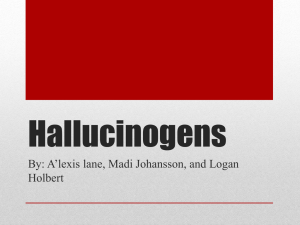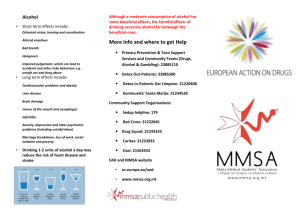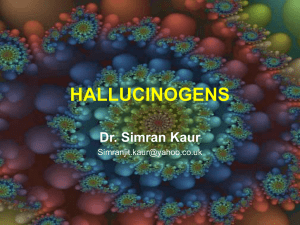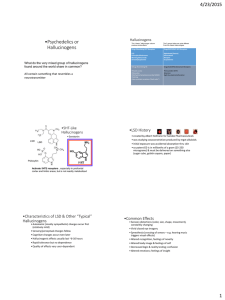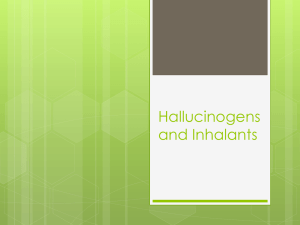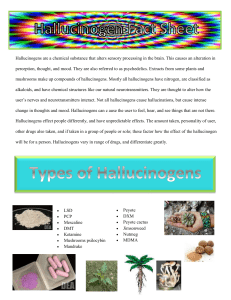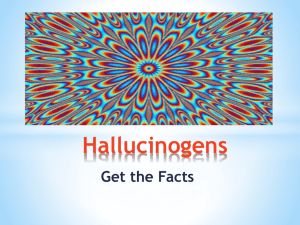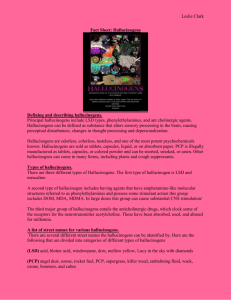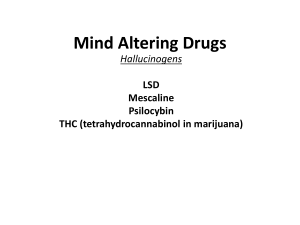Chapter 13 Hallucinogens (Psychedelics)
advertisement
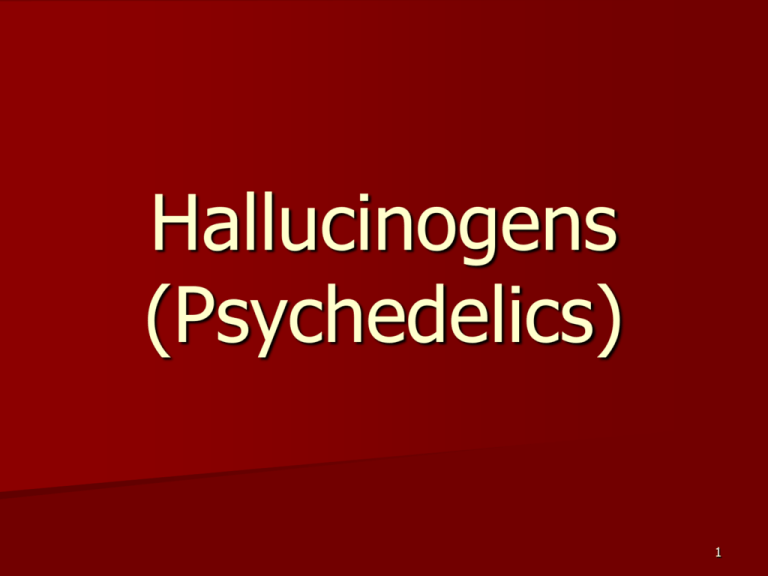
Hallucinogens (Psychedelics) 1 Hallucinogens substances that alter sensory processing in the brain, causing perceptual disturbances, changes in thought processing, and depersonalization 2 Modern day history of hallucinogens The Native American Church – The American Indian Religious Freedom Act of 1978 Timothy Leary and the League of Spiritual Discovery – The Psychedelic Experience 3 The nature of hallucinogens Many drugs can exert hallucinogenic effects – LSD – – types Phenylethylamines Anticholinergic agents 4 Nature of hallucinogens Psychedelic Psychotogenic Psychotomimetic 5 Sensory and psychological effects of hallucinogens Altered senses – Loss of control – flashbacks Self-reflection – synesthesia “make conscious the unconscious” Loss of identity and cosmic merging – “mystical-spiritual aspect of the drug experience” 6 Traditional hallucinogens: LSD types agents LSD (lysergic acid diethylamide), mescaline, psilocybin, dimethyltryptamine (DMT), and myristicin These drugs cause predominantly psychedelic effects 7 Of high school seniors sampled: 11.3% had used in 1975 8.6% has used in 1992 12.2% had used in 1999 8 Traditional hallucinogens: LSD types agents Physical properties of LSD – – In pure form - colorless, odorless, tasteless Street names - acid, blotter acid, microdot, white lightning 9 Traditional Hallucinogens Physiological effects – – – Massive increase in neural activity Activates sympathetic nervous system (rise in body temp., heart rate, and blood pressure) Parasympathetic nervous system (increase in salivation and nausea) 10 Traditional hallucinogens: LSD types agents About half of the substance is cleared from the body within 3 hours, and more than 90% is excreted within 24 hours Effects of this hallucinogen can last 2-12 hours Tolerance to the effects of LSD develops very quickly 11 Other LSD types agents Mescaline (Peyote) – – – Mescaline is the most active drug in peyote; it induces intensified perception of colors and euphoria Effects include dilation of the pupils, increase in body temperature, anxiety, visual hallucinations, and alteration of body image, vomiting, muscular relaxation; in very high doses may cause death Street samples are rarely authentic 12 Other LSD types agents Psilocybin - its principal source is the Psilocybe mexicana mushroom – – – – It is not very common of the street Hallucinogenic effects produced are quite similar to LSD Cross tolerance among psilocybin, LSD, mescaline Stimulates the autonomic nervous system, dilates the pupils, increases the body temperature 13 Other LSD types agents Dimethyltryptamine (DMT) – – – A short-acting hallucinogen Found in seeds of certain leguminous trees and prepared synthetically It is inhaled and similar action as psilocybin 14 Other Hallucinogenic (LSD type) Nutmeg – – – Myristica oil responsible for physical effects High doses can be quite intoxicating Can also cause unpleasant trips 15 Phenylethylamine hallucinogens The phenylethylamine drugs are chemically related to amphetamines. They have varying degrees of hallucinogenic and CNS stimulant effects Phenylethylamines that predominantly: – – Release serotonin are dominated by their hallucinogenic action Release dopamine are dominated by their stimulant effects 16 Phenylethylamine hallucinogens Dimthoxymethylamphetamine (DOM or STP) “Designer” amphetamines 3,4-Methylenedioxyamphetamine (MDA) Methylenedioxymethamphetamine (MDMA) 17 Anticholinergic hallucinogens The anticholinergic hallucinogens include naturally occurring alkaloid substances that are present in plants and herbs The potato family of plants contains most of these mind-altering drugs 3 potent anticholingergic compounds – – – Scopolamine Hyoscyamine Atropine 18 Anticholinergic hallucinogens Atropa Belladonna: The Deadly Nightshade Mandragora Officinarum: The Mandrake Hyoscyamus Niger: Henbane Datura Stramonium: Jimsonweed 19 Other hallucinogens Phencyclidine (PCP) – – It was developed as an intravenous anesthetic, but found to have serious adverse side effects It differs from the other traditional hallucinogens It is a general anesthetic in high doses It causes incredible strength and extreme violent behavior Management of the severe psychological reactions requires drug therapy 20 Other hallucinogens Phencyclidine (PCP) physiological effects – – Hallucinogenic effects, stimulation, depression, anesthesia, analgesia Large doses can cause coma, convulsions, and death PCP psychological effects – Feelings of strength, power, invulnerability; perceptual distortions, paranoia, violence, psychoses, 21 Other hallucinogens: inhalants The most commonly abused inhalants are volatile substances that can cause hallucinations, intoxication, and euphoria. – – – Volatile solvents Anesthetics Nitrites Mild doses - mild stimulations, lack of motor control, dizziness, hallucinations High doses - violent behavior, heart arrhythmia, unconsciousness, death22 22 From the forest to the front lawn? This lecture reviews basic information on most of the hallucinogen and dissociative intoxicants growing throughout the U.S. Psychoactive composition, geographic distribution, and brief overview on preparation and/or intoxication will be reviewed 23 Ephedra – Caffeine-like Stimulant 24 The Ephedra Equation Most “dietary supplements” marketed as psychoactive intoxicants contain ephedrine and/or caffeine from a variety of botanical sources. In China, Ma Huang is used directly as a tea or compounded with other herbs. Historically in the U.S., it was used as a stimulant tea: Mormon Tea, Brigham Tea, and other names. Contains: ephedrine, pseudo-ephedrine, norephedrine, methyl-ephedrine, tannins, saponin, and flavone 25 Ephedra grows in the deserts of the Southwest 26 Ephedra of the US E. trifurca, E. viridis, E. torreyana, E. nevadensis and E. californica 100 gm dried ephedra could contain anywhere from 0 to 2.6 gm of ephedrine Herbalists do offer pure extract preparations 27 Psilocybe Mushrooms: Potent Hallucinogen Psilocybin: 4-phosphoryloxy-N,N-DMT Psilocin: 4-hydroxy-N,N-DMT Psilocybe cubensis typically contains 1.6 mg psilocybin per gram of dried mushroom 40 mcg/kg intoxicates 3 to 4 hour duration 28 Psilocybe Mushrooms Small brown mushrooms that stain blue to the touch Illicit cultivation but also foraged from temperate climates 29 Psilocybe Mushrooms: Religious Use Religious use continues in Oaxaca, Mexico 30 Psilocybin content 31 Dimethyltryptamine – Potent Hallucinogen (DMT) N,N-Dimethyltryptamine 10 to 20 mg smoked : 15 minute intoxication Approximately 100mg oral ingestion in presence of an MAOI: 3-4 hour intoxication Many sources Religious use of ayahuasca continues in Brazil; indigenous and “modern” religions: Santo Daime and Uniao do Vegetal. Both seek permission to use in the U.S. 32 DMT…it’s as common as crabgrass… “Canary” grass; Phalaris aquatica, P. arundinacea, P. canariensis, P. tuberosa Desmanthus illinoensis; Prairie Bundleflower Many other sources; mostly S. America. 33 DMT content Alkaloids reported as mg/100g raw dried plant +++++++++++++++++++++++++++++ ++ P. tuberosa: DMT 100 mg+; 5-Me-DMT 22 mg+; 5-OH-DMT 5 mg P. arundinacea DMT 60+ mg Desmanthus illinoesis (root bark) DMT 340 mg Psychotria viridis: DMT 200 mg 34 Phalaris spp. 35 Desmanthus illinoesis 36 Monoamine Oxidase Inhibitors Sedative-hypnotic properties and possibly hallucinogenic/dissociative properties Sources: Peganum harmala, Passiflora spp., USED TO MAKE DMT ORALLY ACTIVE 37 Peganum harmala 38 Peganum harmala Commonly called Syrian rue Contains reversible MAOIs that may also be psychoactive (2 to 4% beta-carboline content). Ayahuasca’s MAOI source only has 0.5% beta-carboline content. Passiflora: approx. 1% 39 Passiflora incarnata Passion flower; fruit used in drinks; some herbal preparations as a “sedative” 40 Peyote – Potent Hallucinogen Lophophoria williamsii Contains mescaline 41 Natural Range of Peyote 42 Harvesting Peyote 43 Peyote Lophophoria williamsii contains 1.5% mescaline (b3,4,5-trimethoxyphenethylamine) 3mg/kg potent intoxication Up to 8 to 10 hour duration Continued religious use in North America Other cacti used in South America and also… 44 Trichocereus spp. Most popular source of non-sacramental mescaline in the U.S. isn’t peyote… These ornamental cacti can be found almost everywhere 45 The Peyote Ceremony Stewart OC. Peyote Religion. Norman, OK: University of Oklahoma Press, 1987. Aberle DF. The Peyote Religion Among the Navaho. Chicago, IL: Aldine Publishing Co., 1966. 46 The Peyote Ceremony Reasons for a meeting The Road Chief and… Tobacco prayers Ingestion of Peyote Power of song Water ceremony The morning after 47 Lysergic Acid Amide Ipomoea spp. (esp. I. purpurea) Argyria nervosa Morning Glory Hawaiian Baby Woodrose 5-10 grams of seeds 4-8 seeds ingested Aztec: Oliliuqui 48 Salvia divinorum potent hallucinogen Many other Salvia spp. may also contain psychoactive diterpenes. “Salvinorin A” Related to Sage plants/Mint family Does not grow in the United States naturally, but can readily be cultivated. Mexican origin First reported in 1962 but popularity increased via Internet… 49 Salvia divinorum 50 Coleus? 51 Datura stramonium Potent Dissociative 52 Datura Leaves typically cut and smoked Contains atropine, scopalomine, and… Ancient ceremonial use in the U.S. Occasional report of death by ingestion of root Many other sources for atropine and scopalomine…mandrake, henbane… 53 Amanita muscaria Found throughout the U.S. Muscimol is the primary psychoactive alkaloid Dissociative 54 Bufo Frogs… Contains bufontinin but intoxication primarily from 5-Meo-DMT The toad is NOT licked but glands are milked for poison 55 Botanical intoxicants…future mayhem? None of these plants are addictive, other than cultivation of the opium poppy in the U.S., which is not common. Illicit cultivation of Cannabis spp., of course, continues. Eradication of the illicit drug market of hallucinogens may drive the “resourceful” to these botanicals more than today. It is not feasible to eradicate these botanicals from U.S. territory The Internet will drive an ever wider dissemination of information on these botanicals to those seeking this information 56 References 57
